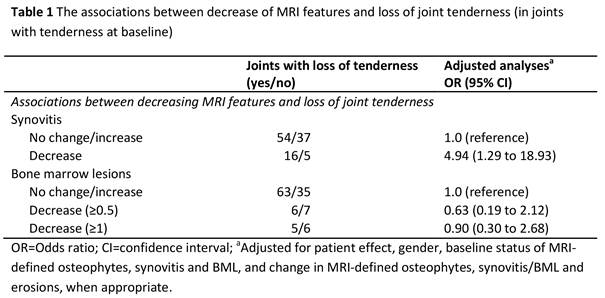Session Information
Date: Tuesday, November 7, 2017
Title: Osteoarthritis – Clinical Aspects Poster II: Observational and Epidemiological Studies
Session Type: ACR Poster Session C
Session Time: 9:00AM-11:00AM
Background/Purpose: Joint pain in hand osteoarthritis (OA) is associated with synovitis in cross-sectional studies. Therefore we hypothesized that synovitis could be a target for treatment. Our aim was to investigate the longitudinal associations between inflammatory features on MRI and joint tenderness in patients with primary hand OA over a two-year period.
Methods: Eighty-five consecutively included patients (81.2% women, median age 58.7 years) with primary hand OA (89.4% fulfilling ACR classification criteria) from a rheumatology outpatient clinic, who received contrast-enhanced MRI and physical examination of the right hand at baseline and at follow-up two years later, were studied. Fat suppressed T2-turbo spin weighted and pre- and post-gadolinium injection T1-weighted sequences were performed in axial and coronal planes on a 1.5 Tesla extremity MR unit. Baseline and follow-up images were scored paired in unknown time order, blinded for clinical data, by one reader according to the Hand OA MRI scoring system (HOAMRIS). Joint tenderness was assessed by trained research nurses. Odds ratios were calculated on joint level (n=680; 8 interphalangeal joints of right digits 2-5 per patient), using generalized estimating equations to account for the within patient effects. Additional adjustments were made for gender, baseline status of MRI-defined osteophytes, synovitis and BML, and change in MRI-defined osteophytes, synovitis/BML and erosions, when appropriate.
Results: Out of 116 joints with baseline tenderness, 73 had loss of tenderness at follow-up. Decrease in synovitis was seen in 21 joints, and decrease in BMLs only in 13. Loss of tenderness was associated in adjusted analyses with a decrease in synovitis, but not in BMLs (Table 1). However, when stratifying for change in synovitis, a decrease in BMLs showed an additive effect (Table 2). Out of 564 joints without baseline tenderness, 103 had incident tenderness at follow-up. Incident tenderness was associated with an increase in synovitis and, to a lesser extent, BMLs. After adjusting for each other it became apparent that synovitis was the main effect modifier and BMLs only had an additive effect (data not shown).
Conclusion: A decrease in inflammatory MRI features is associated with loss of joint tenderness, supporting targeting MRI-defined synovitis in hand OA.
To cite this abstract in AMA style:
van Beest S, Damman W, Liu R, Kloppenburg M. Is a Decrease in MRI-Defined Inflammation Associated with a Decrease in Pain in Patients with Hand Osteoarthritis? a Two-Year Follow-up Study [abstract]. Arthritis Rheumatol. 2017; 69 (suppl 10). https://acrabstracts.org/abstract/is-a-decrease-in-mri-defined-inflammation-associated-with-a-decrease-in-pain-in-patients-with-hand-osteoarthritis-a-two-year-follow-up-study/. Accessed .« Back to 2017 ACR/ARHP Annual Meeting
ACR Meeting Abstracts - https://acrabstracts.org/abstract/is-a-decrease-in-mri-defined-inflammation-associated-with-a-decrease-in-pain-in-patients-with-hand-osteoarthritis-a-two-year-follow-up-study/


